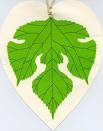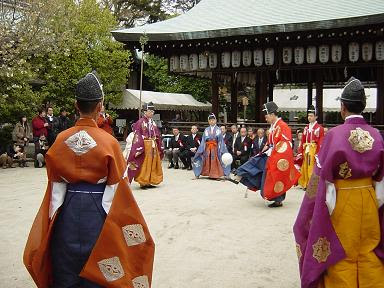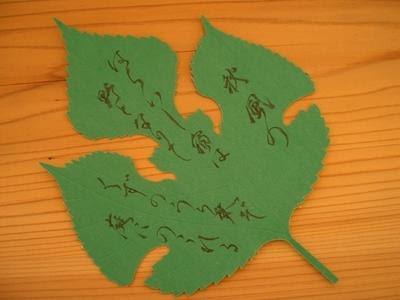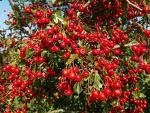::::::::::::::::::::::::::::::::::::::::::::::::::::::::::::::::::::::::::::::::::::::::::::::::::::
Paper mulberry leaf (kaji no ha)
***** Location: Japan
***** Season: Early autumn
***** Category: Plant
*****************************
Explanation

kaji no ha 梶の葉 (かじのは ) paper mulberry leaf
kaji no nanaha 梶の七葉(かじのななは)
"seven lobes of a paper mulberry leaf"
kaji no ha no uta 梶葉の歌(かじのはのうた)
poem on a the paper mullbery leaf
kaji no ha uri 梶葉売(かじのはうり)vendor of paper mulberry leaves
...............................................................................
seven Tanabata princesses 七姫 (ななひめ) nanahime
the seven different names for the Orihime Tanabata princes, Weaver Girl, Vega.
Akisari hime 秋去姫(あきさりひめ) "autumn leaves"
(she has just finished weaving a dress for autumn)
Takimono hime 薫姫(たきものひめ) "incense"
(reminder to an old Chinese legend of Kikoden 乞巧奠)
Sasageni hime ささがに姫(ささがにひめ) "spider"
(she is like a spider weaving her net or weaving her wish into the spider net and hope it will come true)
Momoko hime 百子姫(ももこひめ) "milky way"
(reminder of the pond "Momoko", most probably another name for the milky way)
Ito-ori hime 糸織姫(いとおりひめ) "thread spinning"
(she is weaving robes for the deities)
Asagao hime 朝顔姫(あさがおひめ) "morning glory"
(asagao, another name is "flower of the cowherd" けんぎゅうばな【牽牛花】 , so she is the wife of the cowherd)
kaji no ha hime 梶の葉姫(かじのはひめ)
"princess of the paper mulberry leaf"
.. she writes seven poems on seven leaves and lets them float to her heavenly lover ..
..................................................................................
Broussonetia papyrifera
The Paper Mulberry (Broussonetia papyrifera, syn. Morus papyrifera L.) is a tree in the family Moraceae, native to eastern Asia. Other names include Halibun, Kalivon, Kozo, and Tapacloth tree.
It is a deciduous tree growing to 15 metres tall. The leaves are variable in shape (even on the same branch), unlobed ovate cordate to deeply lobed, with lobed leaves more frequent on fast-growing young plants; they are 7–20 centimetres long, with a rough surface above, fuzzy-downy below and a finely serrated margin. The male (staminate) flowers are produced in an oblong inflorescence, and the female (pistillate) flowers in a globular inflorescence. In summer, the pistillate flower matures into a red to orange, sweet, juicy fruit 3–4 centimetres diameter, which is an important food for wild animals. The fruit is edible and very sweet, but too fragile to be commercialised.
The bark is composed of very strong fibres, and can be used for making high-quality paper.
© More in the WIKIPEDIA !
:::::::::::::::::::::::::::::::::::::::::::::::::::::::::::::::::::::::::::::::::::::::::::::::::::
kaji no ki カジノキ(梶の木)paper mulberry tree and
its leaves are a popular family crest.

鬼梶の葉 and others
source : www.harimaya.com
:::::::::::::::::::::::::::::::::::::::::::::::::::::::::::::::::::::::::::::::::::::::::::::::::::::
kigo for early autumn
kajimari 梶の鞠(かじのまり)
paper mulberry kickball for the
Tanabata star festival rituals
Asukai no mari 飛鳥井の鞠(あすかいのまり)kickball at Asukai
Asukai is an old noble family which has the kickball game as their family tradtion. Now obligatory at the shrine Shiramine in Kyoto.
Tanabata no mari 七夕の鞠(たなばたのまり)kickball at Tanabata
Tanabata no kemari 七夕の蹴鞠(たなばたのけまり)
koozo no mari 楮の鞠(こうぞのまり)paper mulberry kickball

source : kata2.wablog.com
Kemari is a traditional game in which several players (usually eight priests) form a circle and try to kick a ball back and forth between themselves, without allowing the ball to fall to the ground.
No player is allowed to use their hands. When the players kick the ball, they call to each other in way of encouragement. Special traditional clothing is worn, and there are no winners or losers, and no time limits. Therefore, it is important for the players to kick the ball to each other as accurately as possible. Anyone can really play this game, regardless of sex, skill level or age. It is a game to be played and enjoyed.
This game is thought to have come to Japan from China around 1400 years ago.
source : www.kyopro.kufs.ac.jp
*****************************
Worldwide use
*****************************
Things found on the way
In astronomy, the Pleiades, or seven sisters, are an open star cluster in the constellation of Taurus. It is among the nearest star clusters to Earth and is the cluster most obvious to the naked eye in the night sky. Pleiades has several meanings in different cultures and traditions.
© More in the WIKIPEDIA !
*****************************
HAIKU

source : shoshujinet
梶の葉を朗詠集の栞かな
kaji no ha o Rooeishuu no shiori kana
I use a mulberry leaf
as a bookmark
for the Roeishu collection
Yosa Buson 与謝蕪村
Wakan Rooeishuu 和漢朗詠集 Wakan Roeishu
"Japanese and Chinese Poems to recite"

Wakan rōeishū
Compiled by Fujiwara no Kintō ca. 1013.
© More in the WIKIPEDIA !
:::::::::::::::::::::::::::::::::::::::::::::::::::::::::::::::::::::::::::::::::::::::::::::::::::::
梶の葉の歌をしゃぶりて這ふ子哉
kaji no ha no uta o shaburite hau ko kana
sucking on the
mulberry leaf poem...
the crawling child
子宝が蚯蚓のたるぞ梶の葉に
ko-dakara ga mimizu no taru zo kaji no ha ni
the treasured child's
wormy scribbles...
mulberry leaf
Kobayashi Issa

This haiku refers to the Tanabata Festival, which takes place on the seventh day of Seventh Month. According to a romantic legend, two celestial lovers--the stars Altair and Vega--are separated by Heaven's River (the Milky Way). One night a year (Tanabata night), they cross the starry river to be together. In honor of the star lovers, a "Star Poem" is written on mulberry leaves.
The child's poor handwriting resembles the squiggles of earthworms.
Robin D. Gill writes,
"The kaji is and is not a mulberry in the same sense a flowering cherry is and is not a prunus, or plum. It is in the mulberry family but not a mulberry per se. This is important because 'mulberry' makes one think of the silk-worms fed on its leaves and hence the weaver, while the kaji is used for writing poems (about the lovers, the weather conditions and the wishes of the poet) because of other associations, namely the shape is said to resemble sculling oars (the upper two parts of the five-part leaf seem like the handle and the bottom three the oar) or, alternatively, the heart, a good shape to write wishes on.
Such explanation may be a folk invention, for the plant is one of a few held to be particularly sacred in Shinto, but there is more: a sculling/steering 'oar' is also kaji, so most old poems, athough using the Chinese character for the plant, use the word to mean 'oar', for the boat used to cross the river for the starry tryst."
source : Tr. David Lanoue
:::::::::::::::::::::::::::::::::::::::::::::::::::::::::::::::::::::::::::::::::::::::::::::::::::
Tanabata princess -
her poem floats
on a scented leaf
Gabi Greve
(studying for this entry, July 2009)
*****************************
Related words
***** Star Festival (Tanabata, Japan)
Milky Way (ama no gawa)
***** First Kick-Ball Game (mari hajime) New Year
[ . BACK to DARUMA MUSEUM TOP . ]
[ . BACK to WORLDKIGO . TOP . ]
:::::::::::::::::::::::::::::::::::::::::::::::::::::::::::::::::::::::::::::::::::::::::::::::::::::
























